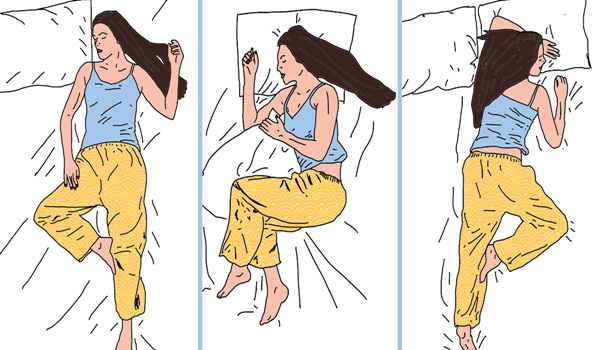Which is the position you usually sleep? This is a very relevant question. Not only getting enough sleep, but how you sleep is also of great importance and it can affect your health.
Learn about the meaning of these 8 sleeping positions:
1. Face Down
A good way to improve your digestion is to sleep on your stomach, and if you don’t find a way to breathe through the pillow, you will probably tilt your face on one side or the other, which can put a lot of pressure on your neck. It can also cause back pain.
2. Fetal Position
This is a good sleeping position if you have problems with snoring or if you’re pregnant. Sleeping all curled up with the knees drawn up and chin tilted down may seem cozy, but it can harm your back and neck.
3. On One Side, With The Arms at Each Side
If you sleep on one side with your arms down at each side, you protect the spine in its natural curve. This can also reduce back and neck pain, and sleep apnea. The disadvantage is that it triggers skin aging, causing wrinkles and sagging breasts.
4. On One Side, With The Arms Out
The advantages of this position are similar to the one with the arms at each side. However, it can induce arm and shoulder pain, since the blood flow is restricted and the nerves are pressured, which may get worse by having your arms out in front of you.
5. On The Right Side
Which side you sleep on is very important if you’re a side-sleeper. Sleeping on the right side can damage heartburn, and sleeping on the left side can pressure your internal organs, for example the liver, stomach and lungs. Doctors typically advise pregnant sleepers to sleep on the left side, because it can help the circulation to the fetus.
6. On Your Back, With The Arms at Each Side
This is usually believed to be the best sleeping position for your neck and spine, but only if you don’t use too many pillows. So, those who sleep on their back are more likely to snore, and sleep apnea is very much linked to this sleeping position, too.
7. On Your Back, With The Arms Up
This is often called “starfish position”, and it is very good for the back. It doesn’t matter if your arms are around your pillow or not, and this position helps in preventing facial wrinkles and skin breakouts. Yet, it can cause snoring and problems with acid reflux. Having your arms up can also strain your shoulder nerves, activating pain.
8. Pillow-Supplementing
Disregarding your favorite sleeping position, you can get better sleep and less pain the following day if you supplement your body with a pillow. The ones sleeping on their back can place a small pillow beneath the arch of their spine, side sleepers can put a pillow between the knees, and the ones sleeping on their stomach can put a pillow under the hips, which supports the joints and provides a full, painless relaxation.



